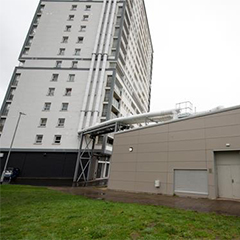New projects could increase the use of large-scale heat pumps manufactured in Glasgow
Scotland already leads the UK in building innovative low-carbon heat networks: schemes recently commissioned in Stirling and Glenrothes use waste and biomass heat
New research released today (Nov 11) shows the Scottish Government’s new Heat Networks Bill could see the equivalent of 460,000 homes heated renewably by 2030, cutting emissions from heat by 10% and helping tackle the climate emergency.
The research, commissioned by industry body Scottish Renewables, found 46 potential heat network projects across Scotland’s seven cities.
The networks would initially serve 45,000 homes but could, with the right Scottish Government support, grow ten-fold by 2030.
Heat networks deliver heat collected from sources as diverse as incinerators, rivers and sewers to buildings via a network of pipes underground. The technology is well established in other countries including Denmark, where the city of Copenhagen is entirely heated this way.
The outlook for Scotland’s low-carbon heat industry is uncertain, with support schemes run by the UK and Scottish Governments soon coming to an end, despite both declaring a climate emergency.
Scottish Renewables is calling on the Scottish Government to use its recently-announced Heat Networks Bill to address this uncertainty and to consider how to support the future growth of heat networks.
Fabrice Leveque, Senior Policy Manager at Scottish Renewables, said: “Heat networks are a mature technology that will allow us to grow our use of renewable heat.
“The Scottish Government’s Heat Networks Bill should be at the heart of an ambitious strategy to stop Scotland from falling behind the rest of the UK in the deployment of this key climate solution.”
To date the Scottish Government has said the new Heat Networks Bill will “support, facilitate and create controls [for] the development of district heating” – but is yet to confirm the details.
In response to this ongoing uncertainty industry has published, alongside the new research, a set of recommendations on how the Bill should support new projects.
The potential projects represent a significant economic opportunity. Civil engineering such as the digging of trenches and laying of pipes accounts for 40% of a typical heat network’s costs, often using locally-sourced labour.


























